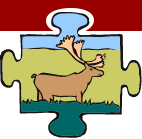|
Fish and Marine Life
|
Back
|
FISH HABITAT, POPULATIONS AND HARVEST
Note: This summary is being revised to reflect the February 2005 updated "State of Knowledge" report.
Indicators:
Population Habitat
- Age distribution - Habitat structure (bottom type and
- Abundance, size and distribution quality)
- Spawning age and number of - Spawning, rearing and over-wintering
eggs produced locations
- Water depth and velocity
Current Knowledge
Fish are an important year-round food source for people in the Northwest Territories. There are 48 species of freshwater and sea-run fish in the North, however only about 50 % of these are harvested. Very few studies on fish, fish habitat and harvest numbers have been completed in the NWT, and these have focused primarily on game species.
Healthy fish populations rely on healthy habitat. When fish populations are doing well, we assume their habitats are doing well. However, some habitats in the NWT have been damaged by development. Climate change also, is thought to affect fish habitat and fish populations.
Biologists use various measurements to determine population health. These include size and age of fish, number of males and females, age when they begin to reproduce, age at death, and their body condition (i.e. fat, vitamin, protein content). However, there are no ongoing studies that look at population health across the territories.
Commercial harvests of fish occur in Great Slave, Kakisa and Tathlina Lakes as well as the north Mackenzie River, with many species routinely harvested at safe levels. In the past, over-harvesting has led to decreases in Lake Trout in Great Slave Lake and Inconnu from several tributaries. Numbers of Inconnu of the Buffalo River, and Walleye of Kakisa and Tathlina lakes have also declined in recent years.
Fish stocks generally, appear healthy, with some exceptions. For example, Arctic grayling populations in the upper Mackenzie River were depleted by disease in 1989, but seem to have recovered.
Management is directed at the conservation and recovery of existing populations. The Aboriginal food fishery for Great Slave Lake is beginning to be documented and the size of the East Arm fishery is being estimated. There have been few problems reported for inland lakes in the Mackenzie Valley.
Current Monitoring
. Fish and marine mammal harvest - Northwest Territories - Fisheries and
Oceans Canada (DFO)
. Monitoring NWT West Area Fish Stocks - DFO
. Lower Mackenzie River Index-netting Program - DFO
. Peel River Fish Study - Gwich'in Renewable Resource Board
. Big Fish River - Cache Creek Dolly Varden Charr Monitoring - DFO
. Rat River Dolly Varden Charr Monitoring Program - DFO
. Sahtu Settlement Area Harvest Study - Sahtu Renewable Resources
Board
. Inuvialuit Settlement Region Harvest Study - Inuvialuit Joint Secretariat
. Aquatic Effects Monitoring Program - BHP Diamonds
. Monitoring of Fish Health and Habitat - Diavik Diamond Mines Inc.
. Monitoring of Fish and Other Animals and their Habitats - Tariuq Ocean
Monitoring Program - DFO
Recommendations to Address Gaps:
The current knowledge-base must be expanded to include the entire NWT, and include harvested, as well as non-harvested species. Since fish habitat and population is dependent on many other factors, a strong linkage with other VCs such as water quality, water quantity and fish quality must be maintained.
Knowledge is greatly improved through the contribution of community-based montoring programs such as index netting.
This summary is based on: A Preliminary State of Knowledge of Valued Compnents for the NWT Cumulative Impact Monitoring Program (NWT CIMP) and Audit. February, 2002.
For more details, you may also want to look at:
Top of page

